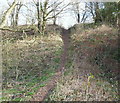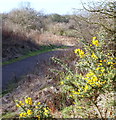1
Great Central Railway embankment
The overgrown embankment of the Great Central main line from Manchester and Sheffield to London Marylebone (1899-1966), just north of Bulwell Hall Estate. Houses on Longford Crescent are on the far left of the picture.
Image: © John Sutton
Taken: 6 Apr 2012
0.10 miles
2
Hucknall By-Pass Vicinity, NG15, Notts.
These houses on Longford Crescent NG6 are under Nottingham's administrative control. Their rear gardens back onto this open space that lies in Ashfield Borough Council's jurisdiction (NG15). This picture was taken from a spot on the Robin Hood Way (the Bestwood Country Park/Moor Bridge tram stop section). To the north of the path and behind a hedge (i.e. behind the photographer) lies an area of land that hosts Hucknall's weekly car boot sales and beyond that the Hucknall By-Pass carries the A611 towards the Wighay Road roundabout, north of Hucknall.
Image: © David Hallam-Jones
Taken: 22 Feb 2014
0.13 miles
3
The northern edge of Bulwell Hall Estate
This was one of the council estates built in the 1930s as the city expanded to the north and west. The picture shows the backs of houses on Longford Crescent. Their gardens end at the city boundary.
Image: © John Sutton
Taken: 6 Apr 2012
0.14 miles
4
Robin Hood Way, Hucknall Aerodrome Vicinity, Notts.
A picture taken from a spot on the Robin Hood Way - the long distance path - south of the Hucknall By-Pass (A611). This is on the Bestwood Country Park/Moor Bridge tram stop section with the tram stop 5 minutes walk away behind the photographer. The eastern end of Hucknall Aerodrome's main runway is a 3-4 minute walk ahead.
Image: © David Hallam-Jones
Taken: 22 Feb 2014
0.18 miles
5
Bulwell Hall Fish Ponds Vicinity, Bulwell, Notts.
These informal tracks, created by mountain bikers, drop down from the top of a former railway embankment into a grassy area to the east of the fishing ponds in Bulwell Hall Park. This embankment carried Great Central Main Line Railway trains between Manchester and/or Sheffield to London via Nottingham, Leicester and Rugby between 1899-1996.
Image: © David Hallam-Jones
Taken: 22 Feb 2014
0.19 miles
6
Leaving Bulwell Hall Park
Image: © Chris Morgan
Taken: 10 Mar 2014
0.20 miles
7
Robin Hood Way, Hucknall Aerodrome Vicinity, Notts.
At this point the Bestwood Country Park/Moor Bridge tram stop section of the Robin Hood Way passes through a gap cut through a former railway embankment, south of the Hucknall By-Pass (A611). Between 1899-1996 this embankment carried Great Central Main Line Railway trains between Manchester-London (via Sheffield, Nottingham, Leicester and Rugby. The NET (Nottingham Express Transit) tram stop lies 10 minutes walk away, behind the photographer. The eastern end of Hucknall Aerodrome's main runway can be seen from a spot 5-6 minutes walk ahead.
Image: © David Hallam-Jones
Taken: 22 Feb 2014
0.20 miles
8
Bulwell Hall Park Fish Ponds, Bulwell, Notts.
The view towards the main recreational area of the park, i.e. the playing field, from between the two adjacent fish ponds. Bulwell Wood Hall, as it was originally known, was built in 1770 by John Newton. In 1908 Alderman Sir Albert Ball J.P. (1863-1946) - former Lord Mayor of Nottingham - bought the Hall and the estate, including 575 acres of land for £35,000. He started his working life as a plumber but by the end of the C19th he had become an estate agent and was living in The Park with an office in Nottingham. Later on he gave the Hall (now demolished) and the park to the inhabitants of Nottingham.
Image: © David Hallam-Jones
Taken: 22 Feb 2014
0.20 miles
9
Bulwell Hall Park Fish Ponds, Bulwell, Notts.
The southern-most pond with the main recreational area (playing field) on the left.
Image: © David Hallam-Jones
Taken: 22 Feb 2014
0.21 miles
10
Bulwell Hall Park Fish Ponds, Bulwell, Notts.
The view towards the point where a river (perhaps a tributary of the River Leen?) runs into this, the first, of two adjacent fish ponds. Bulwell Wood Hall was built in 1770 by John Newton. In 1908 Alderman Sir Albert Ball J.P. (1863-1946) - former Lord Mayor of Nottingham - bought the Hall and the estate, including 575 acres of land, for £35,000. He started his working life as a plumber but by the end of the C19th he had become an estate agent, living in The Park with an office in Nottingham. Later he gave the Hall (now demolished) and the park to the inhabitants of Nottingham.
Image: © David Hallam-Jones
Taken: 22 Feb 2014
0.22 miles

























